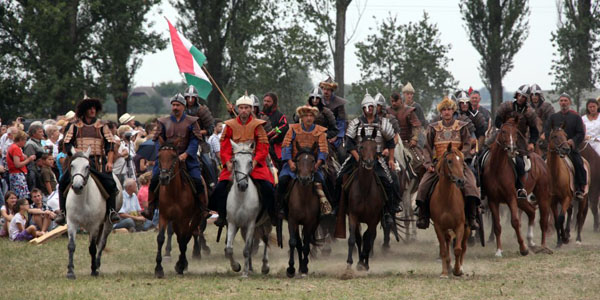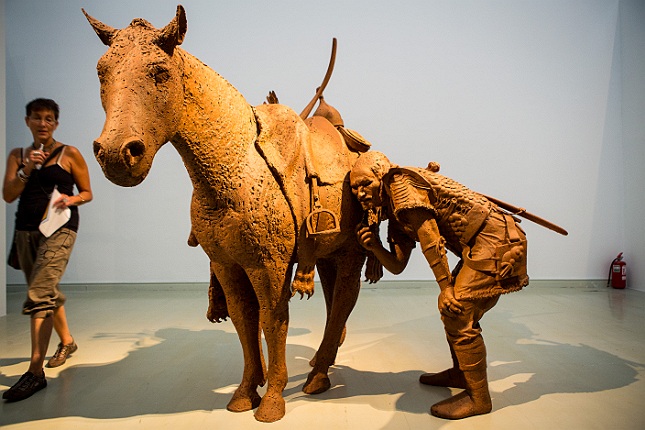The Discursive Asianization of Hungary

Post by Chris Moreh, Northumbria University
This post is part of a partnership with the International Journal of Cultural Studies, where authors of newly published articles extend their arguments here on Antenna.
As a landlocked country in Central Europe, and member of the European Union since 2004, Hungary is unlikely to be considered by many as Asian. Nevertheless, it has thrown itself into the global race to compete for advantageous positions in the postulated new international order dominated by Asia with everything its imagined cultural history and genetic composition of its population had to offer. Since the 2010 electoral success of the conservative center-right, there has been a strengthening public discourse promoting the necessity to open towards Asia, not only for economic reasons but also because of a supposed cultural and racial affinity. I see this ‘Asian discourse’ as made up of heavily mediatized themes which activate and reinforce a specific understanding of what it means to be Hungarian.
The question of ‘what is Hungarian?’ has been a centuries-old concern for intellectuals, artists, and politicians – and a particular answer has been resurfacing in recent years. According to it, even after more than a millennium since they arrived to the Carpathian Basin, Hungarians are still to be considered a ‘Turanic’ people. The term ‘Turan’ or ‘Turanian’ was introduced as a linguistic concept in the 1860s, but it originally had a geographic meaning, referring to the Central-Asian territories north of Iran, inhabited by nomadic tribes hostile to the Persians. While it most commonly describes Altaic-Uralian peoples like the Finns, Estonians, Turks, Mongols, Japanese or Koreans, more inclusive definitions also incorporated the Chinese, the Tibetans and the Indians. By the end of the 19th century the concept had entered into widespread use, gaining additional racial overtones. During the first half of the past century Turanism became part of the extreme right’s official rhetoric, falling into disrepute after World War II, and being evicted from popular knowledge during communism. It was only after the regime change of 1989 that elements of Turanic thought were revived in certain extreme-right circles. Today it is most openly promoted by the radical-nationalist Jobbik party, whose long-held aim is to change the official position of the Hungarian Academy of Sciences on the question of the Hungarian ‘ancestral homeland,’ together with its representation in textbooks.
The most public display of Turanism takes place every two years with the occasion of an international ‘tribal meeting’ (Kurultáj, in Turkic languages) which has been organized in Hungary since 2008. The main organizer of the event is the anthropologist and human biologist András Zsolt Bíró, who maintains close ties with Jobbik, having received the party’s ‘Pongrátz Gergely Cross of Merit’ for his scientific research. His main research centered on genetic tests carried out on members of a Kazakhstani tribe called Madjars, and his findings published in 2009 in the American Journal of Physical Anthropology disclosed a genetic affinity between the Madjars and the Hungarians (Magyars).

Photo by Mudra László (origo.hu). Taken at the exhibition “What Is Hungarian? Contemporary Answers.”
It was against this background that the ‘Asian discourse’ of the Hungarian government began to emerge through themes relating to different – economic, cultural and racial – sub-discourses. The broadest discourse officially assumed by the government at the highest level is that of ‘eastward opening,’ proposing closer economic cooperation with countries in Asia. We can track the emergence of this discourse in several speeches given by the Prime Minister in 2009 and 2010. It first surfaced through the metaphor of Hungary as a ship sailing under a western flag, but having to turn its sail according to an ‘eastern wind’ blowing in the world economy. This economic discourse, however, soon acquired a political and cultural dimension. The event which brought this discourse to the surface was a speech given by the Prime Minister Viktor Orbán in 2012, where he talked about the necessity of ‘power’ (or force) to unite and lead a ‘half-Asian’ nation like Hungary. The speech was especially controversial due to its ambiguity regarding the future of western liberal democracy. What gave more media resonance to the Prime Minister’s words was another event which occurred soon after: the official visit to the Parliament of the representatives of several Asian ‘tribes’ taking part in the Kurultáj. The fact that the Deputy Speaker of the National Assembly officially received the organizers and participants at the Parliament was presented in the opposition media as a formal acceptance of Turanism, an origin theory which remains repudiated by the Hungarian Academy of Sciences.
Later that year, another event caused controversy, this time a statement made by the then National Economy Minister György Matolcsy at a small gathering. Reacting to a question from the audience, the minister defended the Prime Minister’s views regarding the ‘half-Asian’ provenience of the Hungarians by explaining how both Hungarian and Japanese babies share the so-called ‘Mongolian spot,’ a bruise-like birthmark visible on the lower back or buttocks of children in their early infancy. The statement was ridiculed in the left-wing opposition media, but as an unscripted reaction to an attendee’s question, it shows just how deeply the sense of racial affinity with Inner Asian and Far Eastern nations has penetrated into popular cognition.
Such cultural and racial discourses are closely linked to Turanic visions, and have served to support the government’s economic and political discourse of ‘eastern opening.’ Nevertheless, the spread and legitimation of Turanism may in the long run serve the political ambitions of the extreme right, currently in opposition. Showing clear similarities with the Eurasianist discourse promoted in Russia by ideologues close to president Putin, the spread of Turanism in Hungary can also have geo-political repercussions.
[For the full article see Chris Moreh, “The Asianization of national fantasies in Hungary: A critical analysis of political discourse,” published in the International Journal of Cultural Studies.]


